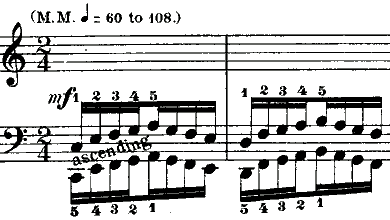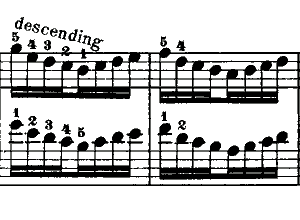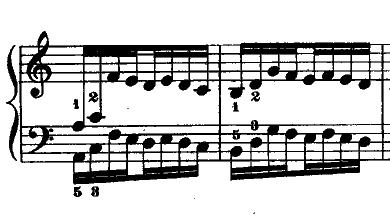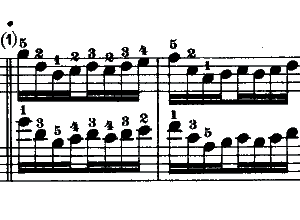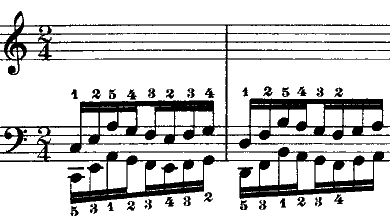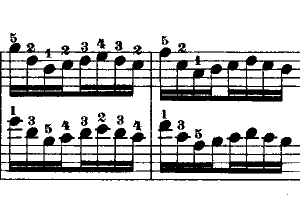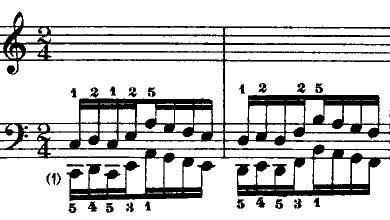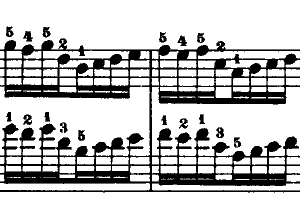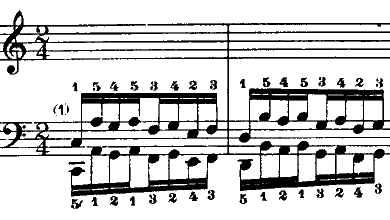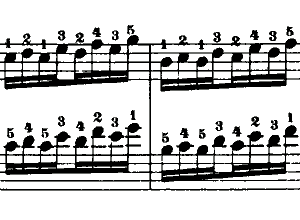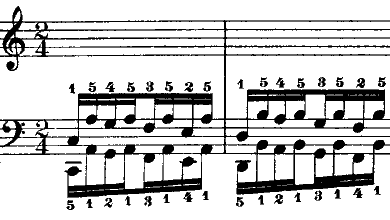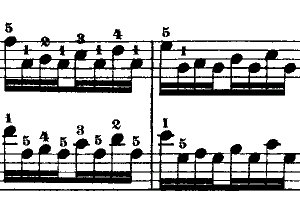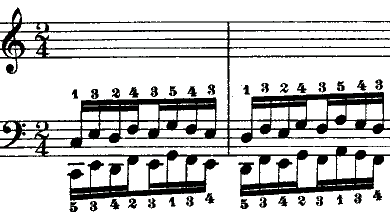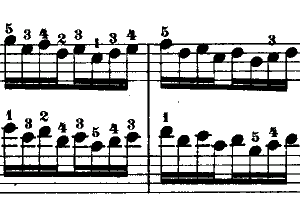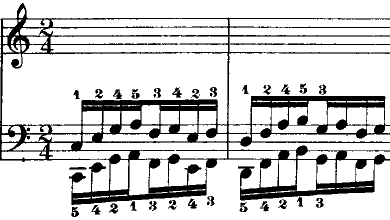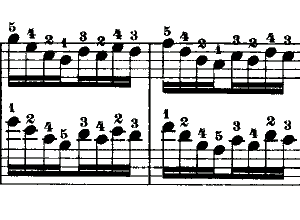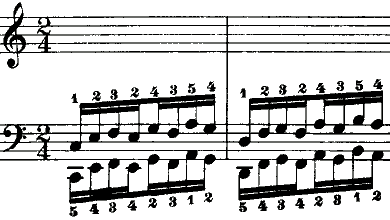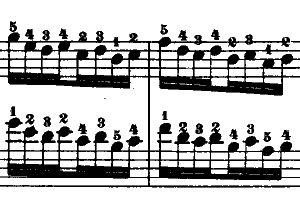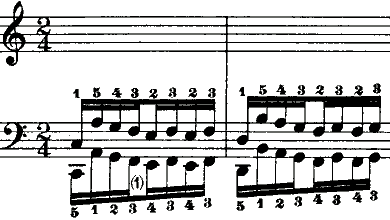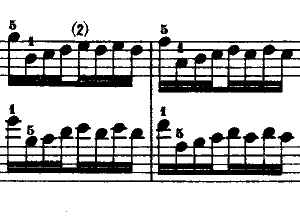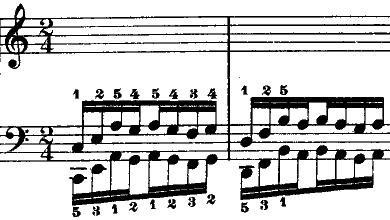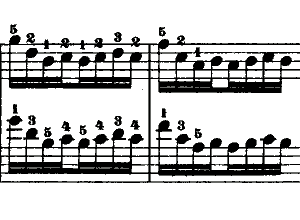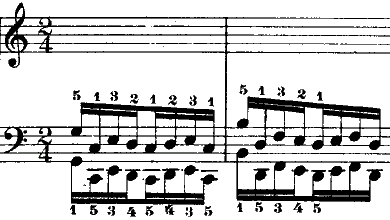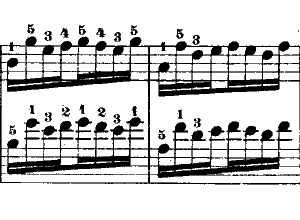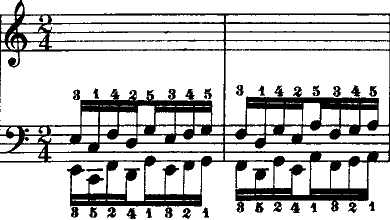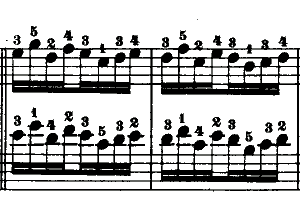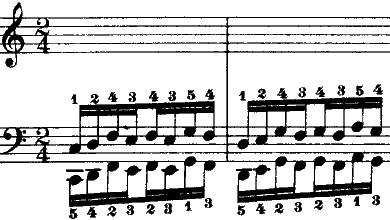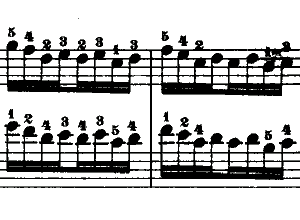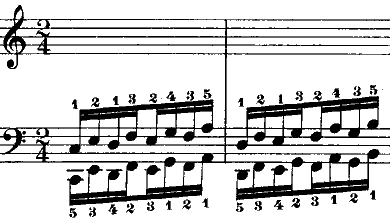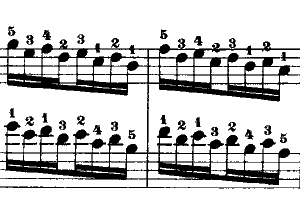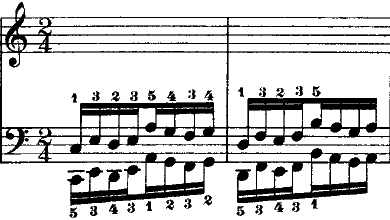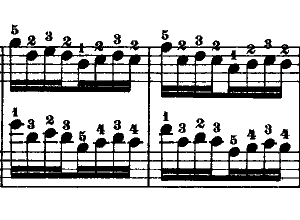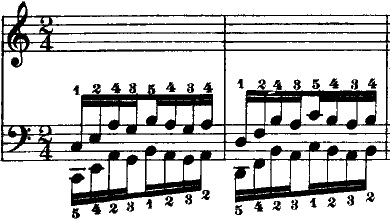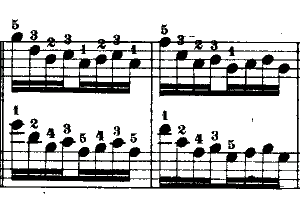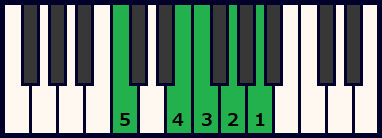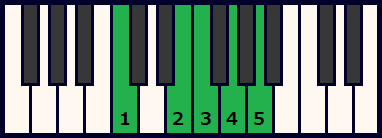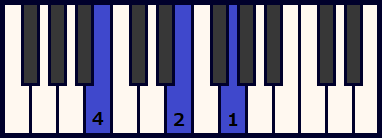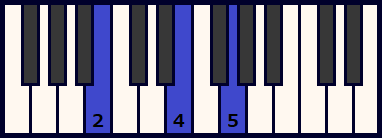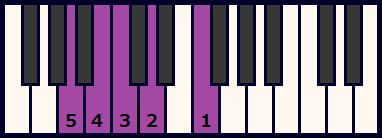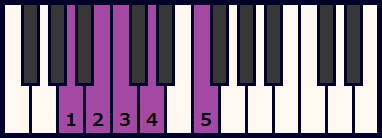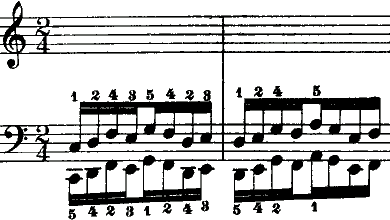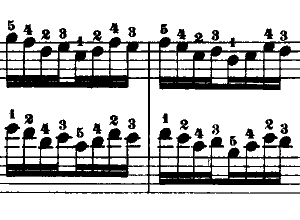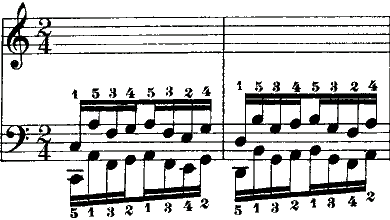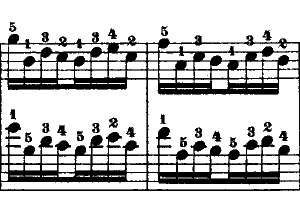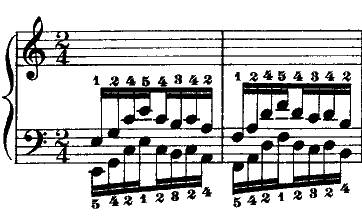
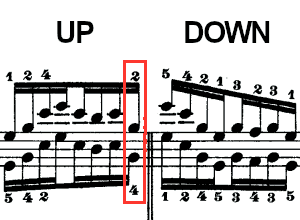
The first real decider
Most of this text will be about my personal journey of Attainment of the transition of exercise 19 to 20 and of exercise 20 itself.
It began with learning exercise 20. The resting finger positioning in this exercise is completely different from all the exercises preceding it.
Below, the resting finger stance at the end of one rep in the up-sequence:
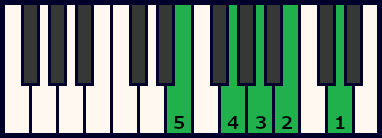
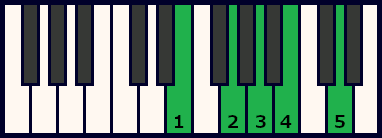
Understanding the resting finger stance is half of the work done. Reading the exercise to find this stance is more complex than for the exercises preceding it mostly because, apart from exercise 17's up-down transition, I never needed to go that far to master them. The finger sequences are so simplistic most of the time that there's no need to go this far. Figuring this all out was an exercise in memory: go to the sheet, check which keys to play with which fingers, finish one rep, understand which fingers to move to begin the next rep and figuring out the pattern. This took its moment, but it was not impossible. Hurdle clear and up-down transition dead ahead, I find yet another fortress to solve.
Below are all the movements and final finger positions at the end of the final rep of the up-sequence.
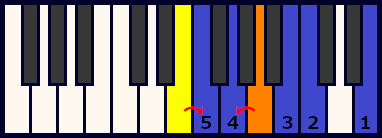
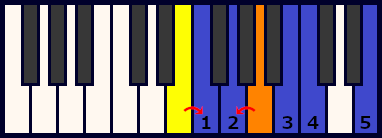
LHF5/RHF1 naturally move from the key shaded yellow to the key shaded blue as the rep progresses. LHF4/RHF2 plays the key it should at the beginning of the rep but, in the up-down transition, instead of playing the key shaded orange, they play the same key as the one in the beginning of the rep. Nevertheless, keeping it over the key shaded orange until it's time to press the key shaded blue again will maintain the hand in the standard resting position shown before, avoiding additional strain on the fingers and wrist.
To understand the resting stance at the end of one rep in the down-sequence, it's important to understand the first half of the rep, as it dictates how the rest of the fingers will move:
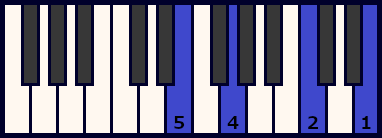
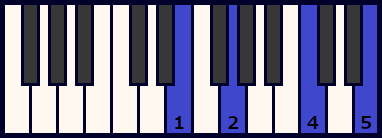
Much like in exercise 17, the subtlety of a different keypress in the final rep prepares the stance to as seamless a transition as possible into the down-sequence.
And now the finger movements and resting stance at the end of a rep in the down-sequence:
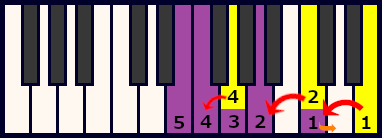
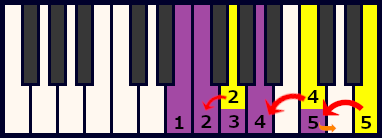
Follow the red arrows to transition from the finger positions in the first half of the rep (shaded yellow), all the way to the resting position at the end of the rep (shaded purple). LHF1/RHF5 must then skip up one key as indicated with the orange arrow to begin the next rep. I found myself dancing with my wrists up and down. This part of the exercise allowed me to gain a level of subtle control over my wrists that I never had before.
But we're not at the end of the exercise yet.
This is the final rep of exercise 20:
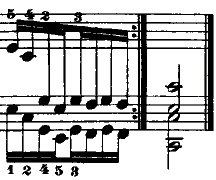
Visalized as:
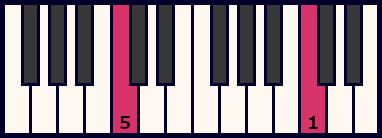
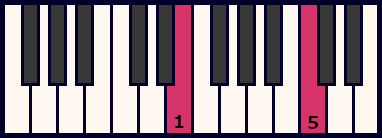
One final pebble on my road to completion. The right hand finishes in a logical place, as the resting position for this hand is already primed for this final keypress. Meanwhile, the left hand has to skip two keys down and extend the hand further to reach the full required octave.
I learned all these details one by one, much like I did exercise 17: first the up-sequence, then the down-sequence, the final keys and then the transition. It must have taken me two weeks. A good portion of that time was spent in disbelief and dismay, abruptly concluding already short 20 minute sessions between procrastination, over what I was reading on the sheet; wallowing in impatience both because I had to keep moving in the sheet back and forth memorizing a repetitive exercise, dedicating to it an amount of brainpower I haven't had to use for any exercise before or since, and also because I was having trouble figuring out the correct stances.
And so the exercise is complete!
Liar
All twenty exercises, under my belt.
Liar
It's time to move on to Volume 2, exercise 21.
LIAR
It's a requirement to play these exercises in sequence.
Exercise 19-20 transition
The Line
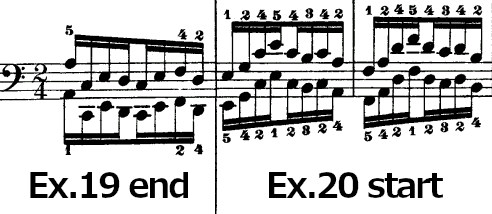
The final of the initial trials
So what's so special about this transition?
Every single exercise from 1 to 19 shares vital traits in their resting stances: for one, they all come back home with RHF1/LHF5 to the Do (C) key. Exercise 19 is no different. Yet, exercise 20 starts with those fingers on Mi (E). This requires one to skip two keys immediately after finishing one exercise. Furthering the issue, it's not just one finger skipping a couple of keys. The resting finger stance also changes dramatically, requiring RHF2/LHF4 to skip a key, then RHF4/LHF2 to skip yet another key.
All taken together:
Abrupt key skip;
Multiple sequential key skips
Finger resting stance shift;
Just thinking about it was enough to lose motivation.
This exercise is so fundamentally different from those that precede it. The exercises coming afterwards will likely introduce all these elements separately and retroactively make exercise 20 easy. I should go study those instead.
The note at the end of exercise 20 stops me:
"After having mastered this First Part, play it through once or twice daily for some time before commencing the study of the Second ("transcendent") Part; by so doing, one is sure to obtain every possible advantage that this work promises. Complete mastery of Part I gives the key to the difficulties found in part II."
I check online if I'm supposed to do 19-20 in sequence or simply pause at 19, readjust my fingers during a 4 beat pause and then proceed with exercise 20.
No such information is found. Written and video evidence that it's meant to be played in sequence, along with my conscience weighing me down.
The door closes. Did I ever do that? Skip a portion of an exercise and study exercises ahead? I did not.
Besides, this is far from the toughest type of transition I'll deal with if I want to become a True Master.
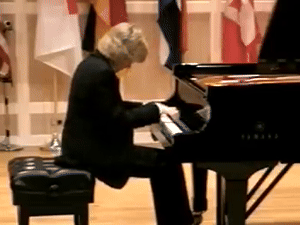

I can't do anything this cool yet. If I begin skipping and leaving difficulties here, I will keep doing it in the future. I'll just need to keep practicing and soon I'll reach their level.
Will I really?
All these people began practcing from an early age. What about me? Besides some faint stints in elementary and middle school, there's a full decade and a half gap of nothing.
Who am I fooling?
I'm looking at and comparing myself to people who have decades of experience under their belt. They have an immesurable headstart. Catching up is impossible.
I can't do it. They did it first and are doing it better. They started before me. I'll be even older than I am now if I ever happen to catch up to them.

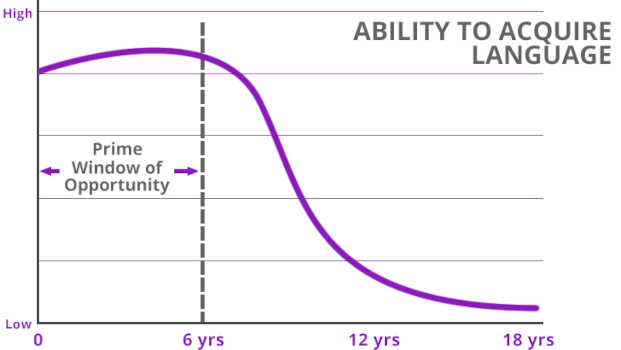
They enjoyed the benefits of a young, plastic mind eager to create all the necessary neural connections to optimize the pursuit of the arts.
My brain is old and room for growth is nigh-existant at best.
These cheating motherfucking pieces of shit.
Who the fuck do they think they are?
I'm gonna catch up on all of you in record time then leave you all in the dust. I'm gonna laugh in your stupid faces that you couldn't hold on to your throne despite me giving you that headstart out of the kindness of my heart. I'm the best and that means I'm better than you. There's no better human being on this planet than スレナガ. I cannot be beat. It's only a matter of time. Fate has decreed that glory belongs to me. Beating this hurdle is but a formality that I shall indulge before breaking it over your face. I won't let them kill me. The shards of my broken Soul are too valuable to lie in the hands of these cheating cunts.
Wrath and pride are part of the main negative forces guiding my life. In violent situations, I never played it cool or landed a simple yet decisive move. In adversity, I always feel slighted by circumstance and push forward with righteous, if unjustified, indignation. Wrath directed inwards, hurt pride projected in all directions.
Mind you, I'm not the type to throw the controller at the wall when I lose a game. I process everything within and move with warped purpose. Although I typically attempt to act with noble heart and high virtue, when the going gets desperate I'll do everything I can to see things through, carrying the type of feelings you won't see motivational speakers or successful public figures ever admit to use as a source of strength. It's not like the virtues and dreams that brought me to this point simply disappear, or were smoke and mirrors all along. They simply take a back seat while the id takes over the wheel.
This would be no different. Landing the first key of exercise 20 coming out of exercise 19 at multiple speeds, then the second key, then the third, and fourth, until I could land the entire sequence. It took me two additional weeks, a lot of grasping at straws, internal strife and multiple prematurely suspended sessions, but I got there!
Persistence fueled by self-hate. It's not pretty, but it helped me through a hurdle. The sequential playing of exercises 1 through 20 would take a while longer, over the course of many months (first mastering 5-15, then 1-15, then 15-20, then 10-20, and finally 1-20, at increasing speeds) but that was more an exercise in patience and endurance than a true test of ability. Still, I only advanced to exercise 21 when I mastered the full sequence. There's a lot to talk about there but it's mostly summarized in my retelling of mastering the 1-10 sequence in my entry about exercise 10.

Hanon Volume 1, complete.
Volume 2 opens its doors to me.
Transcendence awaits.
